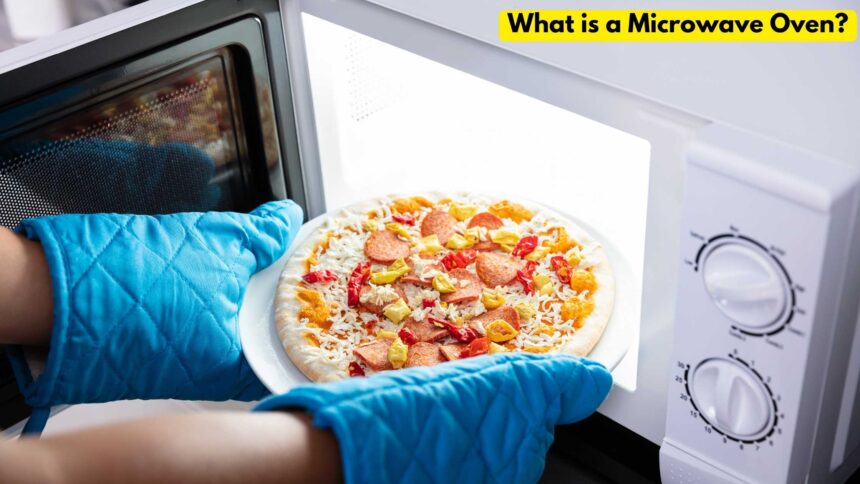What is a Microwave Oven?
The microwave oven, a mainstay in modern kitchens, is a marvel of technology that simplifies our lives. a microwave oven is a kitchen appliance that uses electromagnetic waves to heat and cook food rapidly. It’s a familiar sight on kitchen counters, loved for its convenience and speed. Let me know if you’d like to delve deeper into how it works, and the different types available, or even explore some tasty microwave recipes.
How Does It Work?
Microwaves belong to the electromagnetic spectrum and are akin to radio waves, but they have a significantly shorter wavelength. Unlike traditional ovens that heat air to cook food, a microwave oven uses these waves to directly target food molecules.
- Magnetron: The heart of the microwave is the magnetron, which generates high-frequency microwaves.
- Heating by Vibration: These waves penetrate food, causing water molecules to vibrate rapidly. This vibration creates friction, transforming the microwave energy into heat.
- Uniform Heating (Almost!): As the molecules vibrate, they heat the surrounding food particles, cooking it from the inside out. However, due to variations in density, some areas might cook faster than others, requiring stirring for even cooking.
Types of Microwave Ovens

Microwave ovens come in various configurations to suit different needs and kitchen spaces:
- Countertop Microwaves: The most common type, perfect for everyday reheating and simple cooking tasks.
- Built-in Microwaves: Seamlessly integrated into your cabinetry, offering a sleek and modern look.
- Over-the-Range Microwaves: Mounted above the stovetop, saving counter space and providing ventilation while cooking.
- Convection Microwaves: Combine microwave technology with a fan and heating element for faster, crispier cooking.
Advantages and Disadvantages of Microwave Ovens
Advantages:
- Speed and Convenience: Microwaves heat food much faster than traditional ovens, ideal for busy lifestyles.
- Reheating Leftovers: They excel at reheating leftovers without drying them out.
- Defrosting: Defrosting frozen food is a breeze with the defrost setting.
- Space-Saving: Countertop microwaves are compact, making them suitable for small kitchens.
- Energy Efficiency: Compared to conventional ovens, microwaves use less energy for shorter cooking times.
Disadvantages:
- Uneven Cooking: As mentioned earlier, microwaves can heat food unevenly, requiring stirring or rotating food for better results.
- Limited Cooking Techniques: While some microwaves offer browning capabilities, they generally cannot replicate the browning and crisping achieved in traditional ovens.
- Nutrient Loss: Some studies suggest that microwaving might lead to a slight loss of nutrients, though further research is needed.
List Out the Popular Recipes

Here are some popular microwave recipes
Microwave Mug Meals: Microwave Mug Pizza, Microwave Mug Macaroni and Cheese, Microwave Mug Omelette
Microwave Vegetables: Steamed Broccoli, Microwaved Sweet Potatoes, Garlic Parmesan Green Beans
Microwave Desserts: Microwave Brownies, Lemon Mug Cake, Microwave Rice Pudding
Microwave Snacks: Microwave Popcorn, Nachos, Potato Chips
Microwave Main Dishes: Microwave Chicken Breast with Herbs, Fish Fillets with Lemon Butter Sauce, Beef Stew
Microwave Breakfasts: Microwave French Toast, Breakfast Burritos, Microwaved Oatmeal
Microwave Side Dishes: Quinoa Pilaf, Risotto, Couscous Salad
Microwave Soups: Tomato Soup, Butternut Squash Soup, Chicken Noodle Soup
Microwave Pasta Dishes: Microwave Spaghetti Carbonara, Creamy Alfredo Pasta, Lasagna
Microwave Steamed Dishes: Steamed Fish with Vegetables, Tofu and Broccoli, Steamed Dumplings
Popular Micro Oven Brands with Cost and Reviews
Here’s a list of popular microwave oven brands along with approximate cost ranges and a brief review of each:
- Panasonic
- Cost Range: $100 – $300+
- Review: Known for reliability and advanced features like inverter technology for more even cooking. Good range of models from basic to high-end.
- Samsung
- Cost Range: $100 – $400+
- Review: Offers stylish designs and innovative features such as sensor cooking and ceramic enamel interiors. Varied models catering to different budgets and needs.
- LG
- Cost Range: $100 – $400+
- Review: Well-regarded for smart features, easy-clean interiors, and solid performance. Offers a wide range of models from basic to convection and smart microwaves.
- Whirlpool
- Cost Range: $80 – $300+
- Review: Known for durability and reliability. Offers a variety of models including countertop, over-the-range, and built-in options with basic to advanced features.
- GE
- Cost Range: $100 – $400+
- Review: Offers a broad selection of microwave ovens with solid performance and durability. Includes models with sensor cooking and convection options.
- Sharp
- Cost Range: $80 – $300+
- Review: Known for high-powered microwaves and innovative designs. Offers various models including carousel microwaves and smart countertop options.
- Breville
- Cost Range: $200 – $500+
- Review: Specialises in premium countertop microwaves with advanced features like “Quick Touch” settings and smart cooking functions. Well-regarded for build quality and design.
- KitchenAid
- Cost Range: $200 – $600+
- Review: Offers high-end built-in and countertop microwave ovens with stylish designs and robust features like convection cooking and sensor technology.
- Cuisinart
- Cost Range: $100 – $300+
- Review: Known for compact and stylish countertop microwave models. Offers a good balance of price and features with options for different cooking needs.
- Kenmore
- Cost Range: $100 – $400+
- Review: Offers a variety of microwave ovens with solid performance and affordability. Known for reliability and user-friendly features.
Note: Costs can vary widely based on the model (countertop, over-the-range, built-in), size (compact to large), and features (basic to advanced functions like convection, sensor cooking, and smart technology). Reviews are generalized and based on common consumer feedback. It’s advisable to check specific models for detailed reviews and current pricing.
Precautions While Using the Micro Oven

- Metal is a No-No: Metal objects like utensils can spark within the microwave. Use microwave-safe containers only.
- Don’t Overheat Liquids: This can lead to superheated liquids erupting violently upon opening (boiling over).
- Read the Manual: Each microwave has its own functionalities and limitations. Always refer to the user manual for safe and optimal use.
Conclusion:
This blog dives deep into the world of microwaves, exploring their inner workings, various types, and the tastiest ways to utilize them.
What is Home Automation? How it works?
FAQ’s of Microwave oven
- Are Microwaves safe?
Microwaves are generally safe when used properly. The emitted radiation is contained within the oven and does not leak out. - Do microwaves destroy nutrients in food?
Some Studies suggest a slight loss of nutrients, but this can happen with any cooking method. Overall, the convenience of microwaves can outweigh the minimal nutrient loss. - Can I use plastic containers in the microwave?
Only use containers labelled “microwave-safe.” improper plastic can melt or leach harmful chemicals into your food. - How long does it take to microwave food?
Cooking times vary depending on the food quantity and wattage of your microwave. Always refer to your user manual or recipe instructions for specific cooking times.




